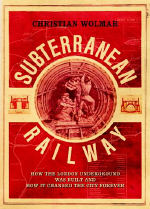Subterranean Railway Review
 Londoners are profoundly ambivalent about the Underground. We dislike it, we mistrust it, but we know we can’t do without it. The complaints have remained constant throughout the system’s 140-year history. It is too crowded, too noisy, too expensive, too stuffy, too unreliable. Yet if it did not exist, London would be a different, barely tolerable city.
Londoners are profoundly ambivalent about the Underground. We dislike it, we mistrust it, but we know we can’t do without it. The complaints have remained constant throughout the system’s 140-year history. It is too crowded, too noisy, too expensive, too stuffy, too unreliable. Yet if it did not exist, London would be a different, barely tolerable city.
Its unpopularity stretches back to before it was built. Nobody wanted it except the entrepreneurs who proposed it. Wouldn’t you have to be crazy to disrupt a thriving capital by digging up its centre? In 1862, a year before the Metropolitan Railway Company opened the world’s first sub-surface line from Paddington to Farringdon, the Times declared that nobody would choose a journey through London’s “foul subsoil” in preference to a breezy ride on a horse bus.
Millions would soon defy that prediction, even though the foulness of the subsoil was, for the first 40 years, compounded by fumes from steam engines. Yet passengers were prepared to tolerate a noxious environment as a price for being carried speedily.
Christian Wolmar is best known as an indefatigable journalist: he unearthed the scandal of John Major’s chaotic privatisation of British Rail. So when he began to research this absorbing history of the Tube, he must have experienced déjà vu. There it all was: the ferocious rivalries, administrative bungles, short-sighted compromises, cost over-runs and delays. Railway politics were ever thus.
In the Victorian era, state subsidies were unthinkable, so it fell to venture capitalists to raise the money. After the Metropolitan, other companies began to build rival lines. Competition was so fierce they would not even agree to share stations or ticketing. Some of today’s cumbersome interchanges are remnants of that stubborn lack of vision.
London was in the midst of a rapid expansion, and once the lines had covered existing suburbs, they penetrated into the open fields beyond. Such rural settlements as Golders Green, Ruislip, Arnos Grove and Stanmore saw an influx of people and houses. Only the Metropolitan Line, though, was able to make significant profits from these developments, since its directors had the foresight to buy land on either side of the route: the nucleus of Metroland. The Metropolitan managed to stay independent while other lines – the present-day District, Northern, Central and Bakerloo – all struggled, and were bought up by the American tycoon Charles Yerkes.
Not until the London Passenger Transport Board, in 1933, was the system unified. Wolmar looks to the 1930s as the golden age of the Underground, when it was run by two gifted executives, Albert Stanley and Frank Pick. Yet it still needed subsidy and was still overcrowded. Any golden aspects were peripheral, such as Charles Holden’s visionary station architecture, some sublime posters and Harry Beck’s definitive system map.
The years after the Second World War are covered in only 20 pages, probably because Wolmar has already written a devastating critique of them in his 2002 book, Down the Tube. For decades, the system crumbled inexorably due to under-investment. He doubts whether Public Private Partnership will succeed in creating the transport system that the city craves. London’s subterranean railway will remain what it has always been, indispensable and unloved.
Review by Michael Leapman, 19 November 2004
